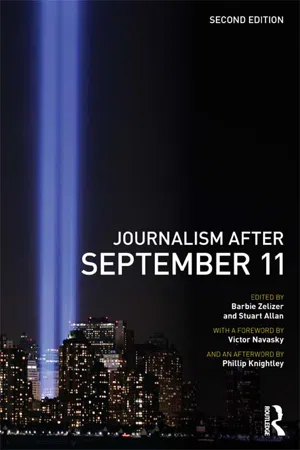
- 342 pages
- English
- ePUB (mobile friendly)
- Available on iOS & Android
Journalism After September 11
About This Book
Praise for the first edition: This collection of essays comes mainly from academics but nobody should bridle at theorists lecturing practitioners. They properly challenge the way September 11th was reported - in a way that's both an endorsement of the role of the media and a wake-up call on its failures... anyone interested in our trade should read it.' - Roger Mosey, Ariel 'A thoughtful and engaging examination of the effects of 9/11 on the field of journalism. Its unique aim is to discuss the impact of the attack as a personal trauma and its current and future effects on journalism and the reporting of the news... highly recommended.' - Library Journal
Journalism After September 11 examines how the traumatic attacks of that day continue to transform the nature of journalism, particularly in the United States and Britain. Familiar notions of what it means to be a journalist, how best to practice journalism, and what the public can reasonably expect of journalists in the name of democracy, were shaken to their foundations.
Ten years on, however, new questions arise regarding the lasting implications of that tragic day and its aftermath.
Bringing together an internationally respected collection of scholars and media commentators, Journalism After September 11 addresses topics such as: journalism and public life at a time of crisis; broadsheet and tabloid newspaper coverage of the attacks; the role of sources in shaping the news; reporting by global news media such as CNN; Western representations of Islam; current affairs broadcasting; news photography and trauma; the emotional well-being of reporters; online journalism; as well as a host of pertinent issues around news, democracy and citizenship.
This second edition includes four new chapters – examining Arabic newspaper reporting of the attacks, the perceptions of television audiences, national magazine coverage of the ensuing crisis, and the media politics of 'othering' – as well as revised chapters from the first edition and an updated Introduction by the co-editors. A foreword is provided by Victor Navasky and an afterword by Phillip Knightley.
Frequently asked questions
Information
Contents
Victor Navasky
Barbie Zelizer and Stuart Allan
The trauma of September 11
Jay Rosen
Michael Schudson
Barbie Zelizer
Roger Silverstone
News and its contexts
James W. Carey
Robert W. McChesney
Carolyn Kitch
Karim H. Karim
Noha Mellor
The changing boundaries of journalism
Stuart Allan
S. Elizabeth Bird
Michael Bromley and Stephen Cushion
Simon Cottle
Marie Gillespie
Reporting trauma tomorrow
Silvio Waisbord
Annabelle Sreberny
Ingrid Volkmer
Howard Tumber
Contributors
Table of contents
- Front Cover
- Journalism After September 11
- Communication and Society
- Title Page
- Copyright
- Dedication
- Dedication 1
- Contents
- List of contributors
- Foreword
- Introduction: when trauma shapes the news
- Part I The trauma of September 11
- 1 September 11 in the mind of American journalism
- 2 What’s unusual about covering politics as usual
- 3 Photography, journalism, and trauma
- 4 Mediating catastrophe: September 11 and the crisis of the other
- Part II News and its contexts
- 5 American journalism on, before, and after September 11
- 6 September 11 and the structural limitations of US journalism
- 7 “Our duty to history”: newsmagazines and the national voice
- 8 Covering Muslims: journalism as cultural practice
- 9 “Why do they hate us?”: seeking answers in the pan-Arab news coverage of 9/11
- Part III The changing boundaries of journalism
- 10 Reweaving the Internet: online news of September 11
- 11 Converging into irrelevance?: supermarket tabloids in the post-9/11 world
- 12 Media fundamentalism: the immediate response of the UK national press to terrorism—from 9/11 to 7/7
- 13 Television agora and agoraphobia post-September 11
- 14 “Our ground zeros”: diaspora, media, and memory
- Part IV Reporting trauma tomorrow
- 15 Journalism, risk, and patriotism
- 16 Trauma talk: reconfiguring the inside and outside
- 17 Journalism and political crises in the global network society
- 18 Reporting under fire: the physical safety and emotional welfare of journalists
- Afterword
- Index